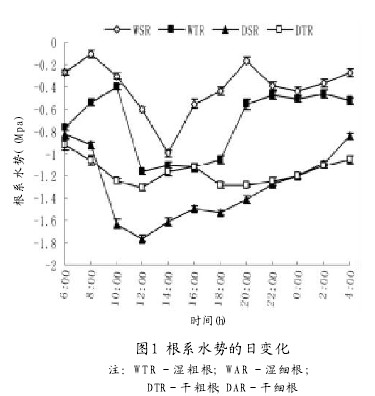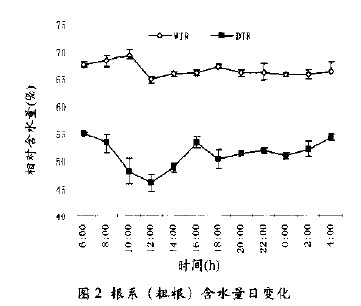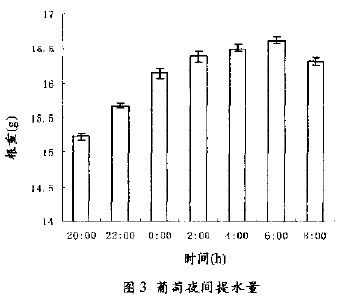The concept of water lift in roots was proposed and officially named by Caldwell and Richard in 1989. Water lifting refers to the phenomenon that part of the root system in the deep moist soil absorbs water when the root system of the plant is reduced in transpiration, and is transported to the shallow root system through the transporting tissue, and then released into the surrounding relatively dry soil. Under drought conditions, plants can maintain the survival of shallow roots and maintain their normal physiological metabolism through deep root water extraction.
So far, this research has been extended to more than 20 plant species such as trees, shrubs, pastures, and crops. The generality and objectivity of its occurrence have been confirmed by more and more experiments, as this phenomenon can increase the The ability to survive in arid environment and show a certain water-saving potential, it may have important application value in the development of water-saving agriculture and animal husbandry production in dryland.
Due to the complexity of the lifting of the water itself and the difficulty of testing, the mechanism of this research and the research on fruit trees have not been reported. This experiment primarily discussed the relationship between water lifting and transpiration of grape roots in order to better understand the compensation function of the root system. This is also the theoretical basis for the application of alternative irrigation technology (PRD-AI).
1 Materials and Methods
1.1 Test Materials and Treatment Tests
In 2005, it was conducted at the Fruit Cultivation Physiology Laboratory of Shandong Agricultural University. Three-year-old Cabernet Sauvignon grape seedlings were used, one for each pot, leaving two new shoots. The grape seedlings grew normally. On August 22, the same growing plants were selected and the pots were rinsed. The roots were rinsed and the roots were evenly divided into two parts corresponding to the upper shoots. Half of the roots were placed in plastic buckets filled with distilled water, ie, in a saturated water supply. State, while the other half of the roots are in arid state. The drought treatment was divided into two types. The first species (I) was placed in an empty bucket to facilitate the determination of root water potential and water content; the second species (II) was to place half of the root system in a tile basin with a relative moisture content of 35.3. % (heavy water stress level) in clay loam landfill. Plastic barrels were shaded with a black plastic film, and 6 strains were treated. The daily change of each index was measured immediately after the root treatment.

1.2 Measurement methods
The leaf water potential and soil water potential were measured with PSΨPRO water potential meter; the balance time of the leaf water potential and root water potential was determined to be approximately 0.5 h; roots and leaves were measured at every 2 h with a root analyzer, and fine roots of less than 0.5 mm were used to measure the root surface water potential, 2 A rough root of ~3 mm measures the root cross-sectional water potential. The soil water potential probe was buried in the root-dense area of ​​the potted soil body during transplanting, and the root water content was measured by taking the coarse roots, weighing and drying.
Diurnal change of photosynthetic rate: measured by CIRAS-1 photosynthetic system at 8:00 to 18:00, once every 2 hours, natural light intensity, air temperature 30 to 40°C, and 3 pieces of full-expanded leaf in each treatment, repeating 3 Times. Experimental data was processed with spss.
Root water pumping capacity measurement: At night, one whole grape plant treated with air drought treatment was fixed on a metal platform, a plastic barrel with water immersed in the root system was placed in parallel with the sky platform, and the other half of the drought root system was wrapped in a balance with a black plastic bag. Above, it was measured once with a root analyzer every 2h.
2 Results and Analysis
2.1 Daily changes in water potential and water content of grape roots
It can be seen from the diurnal variation of the water potential of the roots of the Cabernet Sauvignon raisins on both sides (Fig. 1). The water potential of the fine roots and the coarse roots is different for the side root system with adequate water supply.
Rough water potential starts at 6:00 every morning

High, rapidly decreasing after 10:00, falling to the minimum at 12:00, then slowly increasing, reaching the highest water potential at 10:00 in the evening, and then slowly decreasing, reaching a minimum of -0.77 Mpa in the morning at 6:00. Compared with the fine root water potential, the coarse root water potential is always smaller than the fine root water potential, and the time to reach the highest and lowest water potential lags behind by 2 h, indicating that it takes a certain time for the water absorbed by the fine root to enter the rough root; at the same time, the fine root water potential at night is slightly The increase in root height and a slight decrease in root mass indicate that the different forms of roots at night have different absorption and running functions.
The dry-rooted root system showed a regular pattern of drop-rise-fall-rise in both the fine roots and the rough roots from the time of measurement from 6:00 am to 00:00 midnight, and the water potential of the roots reached the maximum at 6:00 in the morning. At 12:00 noon, the water potential fell to its lowest level, and then slowly began to rise again. After a slight decline at 4:00 pm, it rose again. The water potential of the coarse roots was significantly higher than the fine root water potential for most of the time, but the difference was not significant at night, indicating that the water movement between the thick roots and fine roots was greatly affected by the external environment, especially the transpiration of the leaves.
The daily changes in root water content (mainly coarse roots) under different water conditions also demonstrated the water lifting effect of the root system. The moisture content of the wet root system was above 64.9% in 1 day, while the root water content in the dry soil was only 55.2%, and the difference was 34.3% at 10:00 in the morning. Corresponding to the change of water potential in the root system, the diurnal and temporal changes of the root water content on both sides of dry and wet were basically consistent with the water potential of the coarse root (Fig. 2). There were 2 peaks of water content in 1 day, and the first peak of the drought-side root system contained The amount of water appeared at 6:00 in the morning, 4h ahead of the wet side, while the second peak of water content appeared in the afternoon at 4:00, 2h ahead of the wet side. Both of them showed the lowest water content at 12:00 noon, indicating that the moisture in the roots of the nighttime drought entered. When the transpiration began, the water content began to decline, while the wet roots were always in a water-absorbing state, and the water absorption capacity was enhanced with transpiration. It is worth noting that after the lower transpiration in the upper part of the area, the water potential of the wet root gradually rises, while the water content slightly decreases. At the same time, the root moisture content of the dry side begins to rise, indicating that when the stomatal closure or partially closed transpiration rate is low There is water running to the root system on the side of the roots, and these waters are not absorbed from the outside by the root system. It is proved that there is a water lifting function in the root system of the grape. The root system with high water content can turn the water to the root system with low water content. .
2.2 Daily changes of photosynthetic parameters in grape leaves
The photosynthetic parameters of arid grapevine leaves were determined as shown in Table 1. The results showed that: 1) With the increase of light intensity and temperature, regardless of air drought or soil drought root, the corresponding leaf transpiration rate and stomatal conductance Significantly reduced, the two types of changes in the trend of the same, at 2:00 pm leaf transpiration rate reached the lowest decline of 72.4% and 78.5%.

2.3 The amount of water lifted at night in grape roots
The real-time monitoring of the amount of water entering the arid side of the root system from the root of the saturated moisture content side at night with an electronic balance. The results showed (Fig. 3): Starting from 8:00 PM, the dry root weight continued to increase and reached the highest level by 6:00 in the morning. The actual increase in water volume was 1.4 g, which began to decrease after lighting, indicating that the grape transpiration was stopped at night. At that time, the moisture can be transferred from the wet root side to the dry root side, showing a clear water lifting effect. When the transpiration increases during the day, the moisture content of the drought-side root system begins to decrease again.
2.4 Diurnal variation of soil water potential and leaf water potential in grape root system
The results of the determination of water potential in the micro-domain soil in the dry area (Fig. 4) show that the rhizosphere soil water potential remained stable from 8:00 am to 4:00 pm and the soil water potential at night slowly increased until 6:00 in the morning. The highest -2.5 Mpa was reached, followed by a slow decrease, indicating that the root system has released water outwards, that is, the external water is released into the soil through the root system. The change of soil water potential is contrary to the change of transpiration rate, but the response is lagging, which means that it takes a certain time for the water to absorb and operate in the root-soil. The change of the root water content can not immediately cause the change of soil moisture content. Correlation analysis of soil water potential and transpiration rate showed no significant correlation between the two.
The results of the determination of grape leaf water potential (Fig. 5) showed that the leaf water potential increased gradually at night, and the leaves of the two drought types reached the highest point at around 8:00 in the morning, reached the lowest point at 2:00 in the afternoon, and recovered slightly in the evening. However, the leaf water potential in the air-drying mode increased rapidly and the decline rate was also large. This may be because the root system exposed to the air is greatly affected by the external environment and lacks the exchange of moisture with the soil, causing the amplitude of the water level of the above-ground leaves to change. Larger. Correlation analysis showed that leaf water potential was significantly correlated with transpiration rate (r=0.957), while leaf changes with moderate drought showed that the soil had better buffering capacity and the correlation between leaf water potential and transpiration rate was significant (r). = 0.912).
3 Discussion
The research on the effects of water lifting on soil water conditions, the number of water lifting functions, the relationship between water lifting and transpiration, and the differences in water extraction and heritability were studied in foreign countries. The domestic scholars mainly studied the effects of water lifting and nutrients. The relationship between sexes, and this study preliminary study of grape water lifting effect.
Experiments showed that the grape water lifting effect was closely related to the transpiration rate. There was almost no transpiration in the night grape leaves, the water potential and water content of the dry root increased, indicating that water entered the root system; and the daytime increased with the transpiration rate and stomatal conductance. The water potential of the dry roots gradually decreased. In the afternoon, the stomata of the grape leaves were completely or partially closed due to the increase of light and temperature, and the water potential of the roots of the dry roots increased again. This shows that due to the suppression of transpiration and stomatal opening, the root water potential in the air rises, and the water content increases. This part of the increase in water content is likely to come from the root system with high water content.
There was a significant difference in water content between the wet root side and the dry root side for 1 day, which indicated that there was a significant moisture gradient between the moisture content of the roots on both sides of the wet and dry sides, which may be the driving force for moisture to enter the dry root side from the wet root side. In the end, how much water gradient is needed on both sides of wet and dry (ie, the soil moisture condition where water lifting can take place) can only occur when water is not transferred. It needs further research to confirm. The water dynamics of roots around the roots were consistent with the changes in the root water potential of the air drought treatment, but the magnitude of the change was small. This may be due to the fact that the amount of water running through the roots with higher water content and released into the soil is not enough to cause soil The water potential has great changes. At this time, the amount of water that the wet roots run to the side of the dry root at night is only 1.4 g, which is a great disparity with the previous test results, which may be due to experimental treatment and measurement methods.
The existence of water lifting effect in the grape root system also confirmed the feasibility of the “partial root zone drought (PRD)†alternative irrigation theory.
Because the water lifting function allows the drought-prone root system to receive water from the side of the irrigation root system, maintain basic survival, and when it encounters irrigation, it can also perform over-compensation functions, and increase the tree growth without significantly inhibiting tree growth. Grape yield and quality, while improving water use efficiency. At present, people's understanding of the role of water lifting in the root system is still very shallow. Further research on the role of water lifting and elucidation of its internal mechanisms are of important practical significance for solving practical problems in production.
PVC sponge roller is a kind of sponge used for cleaning, the sheet size can be customized. We will provide you with high quality and fast deliver time.
PU Sheet,PU Cleaning Sheet,PU Cleaning Wiper,PU Wiper
Welltronics Technology Limited , https://www.welltronics.cn